Many entrepreneurs hit limits no longer as a result of they lack concepts, however as a result of they may be able to’t execute or scale them.
Now not everybody has the luxurious of builders, designers, or analysts who can lend a hand flip giant concepts into fact. Despite the fact that you do, you continue to wish to compete for time and lend a hand with the remainder of your organisation.
However occasions have modified. AI gear like ChatGPT make technical finding out radically extra out there. It’s now conceivable to develop into “technical” even supposing you’re a humble creator, social media marketer, or logo strategist—as a result of all of us have get entry to to a affected person, succesful technical tutor within the shape of a giant language style.
I’m a lifelong marketer and non-technical individual. I all the time sought after to discover ways to code, however by no means knew the place to begin. I bounced off part a dozen coding lessons, till I realised that ChatGPT is the easiest trainer and troubleshooter. Now I will name APIs, write easy scripts, and automate portions of my workflow:
If I will do it, you’ll be able to too.
Ever wanted you should pull reside information from gear like Ahrefs, social platforms, or inside product analytics—with out ready on engineers?
The solution: APIs (Software Programming Interfaces) are gear that permit other device communicate to one another. They liberate get entry to to information that may accelerate aggressive analysis, automation, or even construction customized dashboards.
I used ChatGPT to discover ways to use the Ahrefs API to fetch my top-performing content material, observe SERP volatility, and observe inbound links mechanically. We damage down the way it works in our Ahrefs API guide.
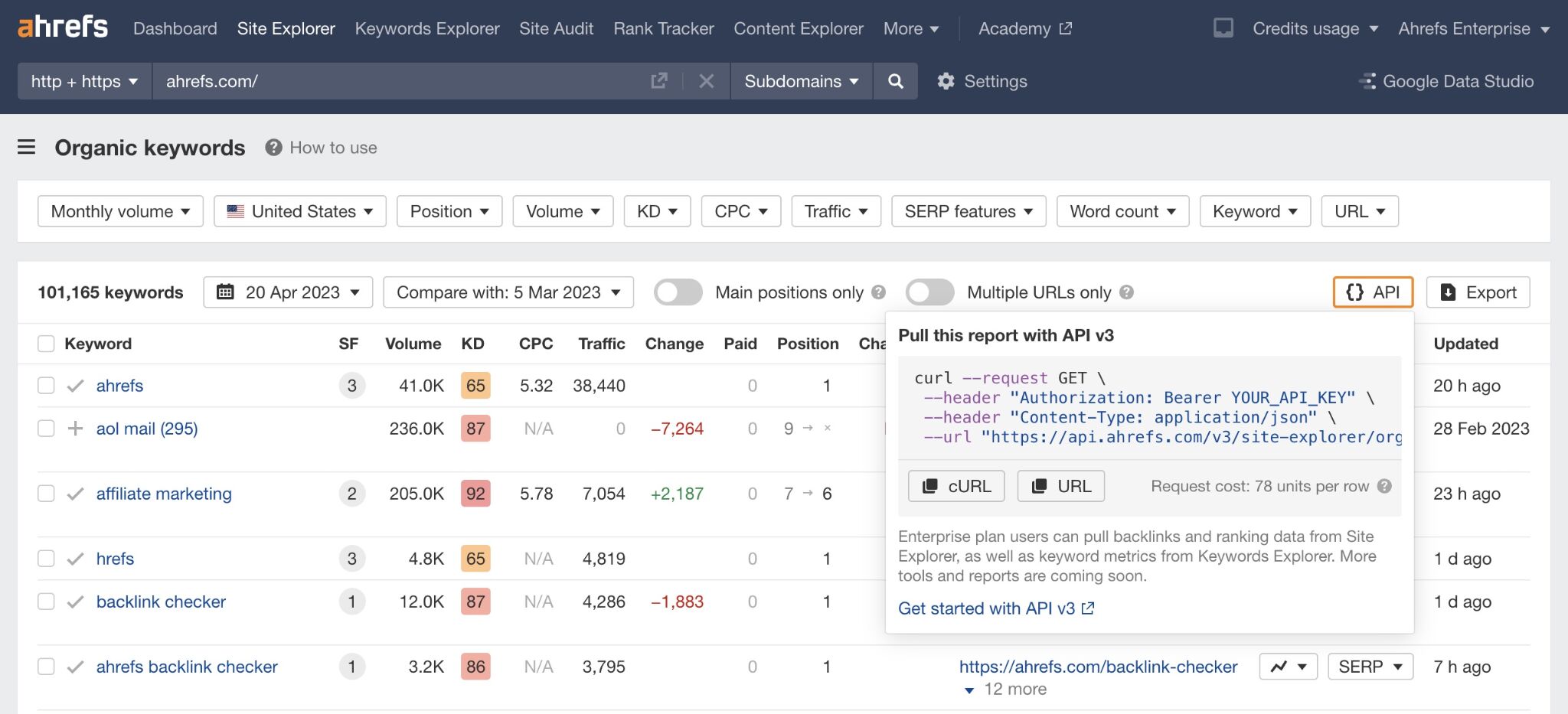
Use the API button in Ahrefs to get a way for the way API requests are structured. If in case you have get entry to to the Ahrefs API, you’ll be able to read our documentation or even make free practice requests.
The way to get began:
- Be told the fundamentals of HTTP requests, authentication (like API keys), and reaction parsing (normally JSON). Try Mozilla’s API guide, Postman Learning Center, or RapidAPI’s beginner tutorials.
- Take a look at your first reside request the usage of Postman to hit a easy endpoint, like fetching climate or headlines. For added apply, check out calling a public endpoint just like the News API to fetch the newest articles on any key phrase—helpful for content material ideation or tracking business developments.
- Use ChatGPT to write down a Python script the usage of requests, provide an explanation for each and every line, and maintain API authentication. Paste in API medical doctors—it could lend a hand translate them into running code.
What if you happen to didn’t must look ahead to an analyst to drag your numbers? That’s the ability of SQL—a common language for asking questions on information.
I take advantage of ChatGPT to lend a hand write SQL queries that pulled weblog publish impressions, clicks, and reasonable place from Google Seek Console—damaged down by means of URL and date. Then I used the ones insights to prioritize which articles to replace and re-promote.
(This works nice along a complete content audit process.)
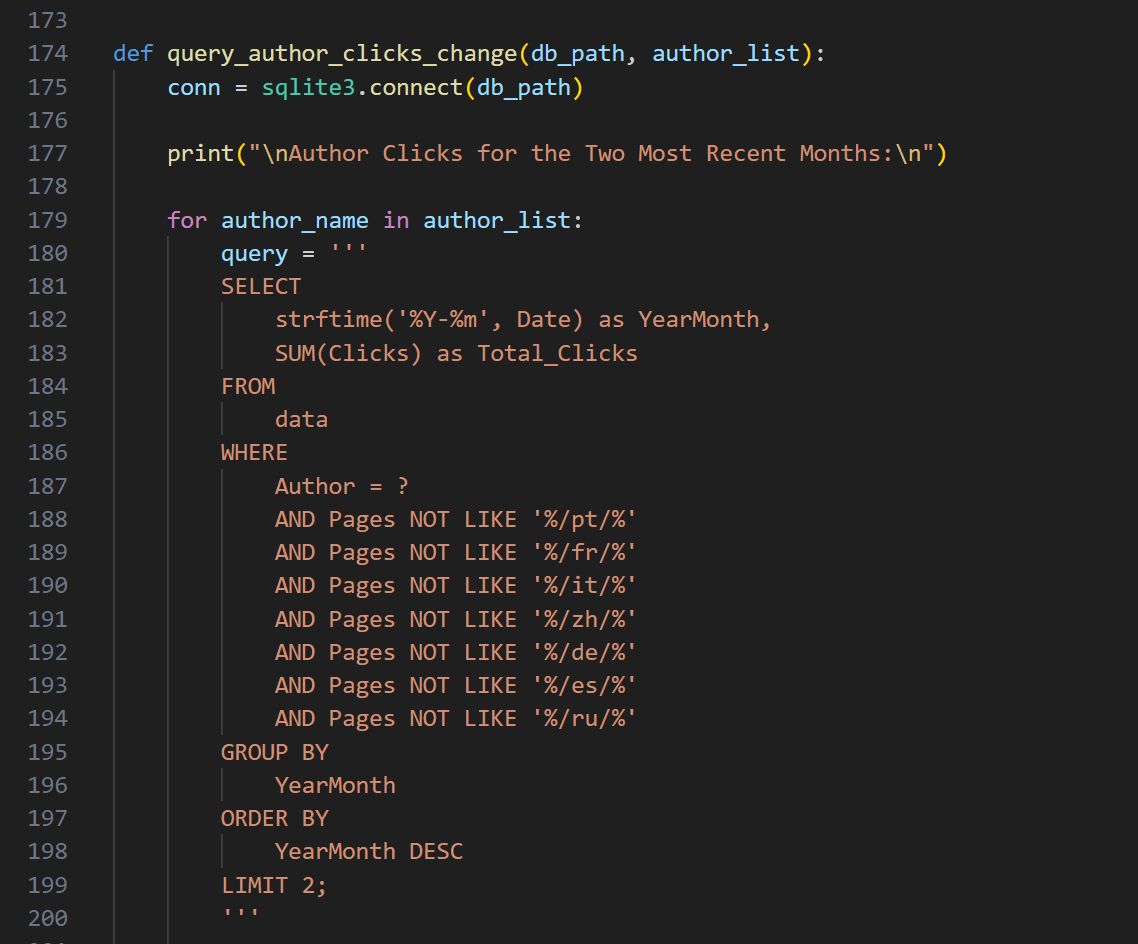

One of the SQL queries I take advantage of as a part of my weblog reporting procedure. This case selects URLs from our global blogs (/es/ is Spain, and so on).
The way to get began:
- Focal point on finding out SELECT, WHERE, GROUP BY, JOIN, and CASE statements. For a very good beginner-friendly walkthrough, check out Mode’s SQL tutorials or LearnSQL.com’s SQL Basics Track.
- Use unfastened gear like Mode, DB Fiddle, or BigQuery sandbox to write down and check your queries.
- Paste your desk schema (column names and kinds out of your spreadsheet) into ChatGPT and describe what you need to measure—it’s going to write and provide an explanation for the whole question.
Unwell of repetitive duties clogging up your day? Learn to automate your maximum mundane, repetitive duties, and you’ll be able to liberate your time for extra thrilling issues.
Automation platforms like Zapier and Make will let you construct “if-this-then-that” good judgment throughout your whole advertising gear—with out touching code. It’s technically “no-code,” however don’t be fooled—it nonetheless teaches you methods to assume like a programmer: environment stipulations, chaining steps, dealing with exceptions, and reasoning thru good judgment flows.
Right here’s a perfect easy Zap that syncs adjustments in our grasp content material spreadsheet with spreadsheets for each and every of our global blogs—on this case, notifying the Eastern advertising workforce that new articles are in a position for localization:
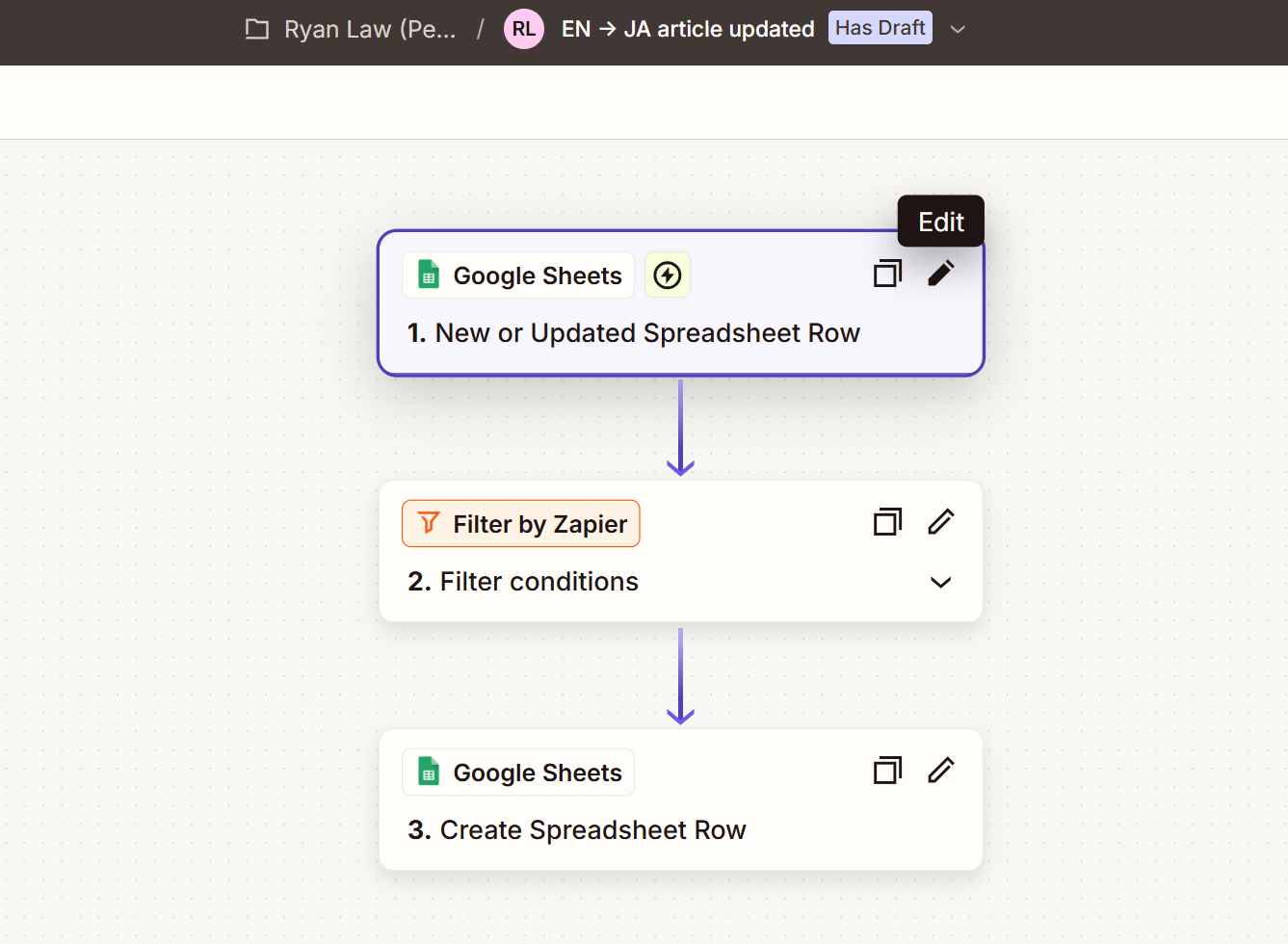

I’ve used Zapier for 100 various things: managing touch shape submissions, triaging leads, triggering editorial workflows for content material, syncing information between other spreadsheets, developing notifications in Slack, you identify it.
The way to get began:
- Get started with Zapier’s template library or Make’s visual scenario builder.
- Construct a easy multi-step automation that makes use of filters, stipulations, and formatting. Zapier’s getting started guide is beneficial if you happen to’re new.
- Ask ChatGPT to map out good judgment flows or generate JSON webhook payloads for extra complicated steps. You’ll be able to additionally paste in present Zap or Make configuration main points and ask it to optimize or troubleshoot them.
Apps Script (a type of JavaScript) allows you to create automations and integrations inside of Google Sheets.
You’ll be able to use Apps Script to ship automatic e mail summaries, archive shape responses, merge information from a couple of Sheets, or cause Slack indicators when new information seems. I take advantage of a script that mechanically fetches creator information from newly revealed weblog posts in our CMS and logs it to a shared Google Sheet—so I may just observe who used to be publishing what, with out chasing down teammates or manually copying information.
Apps Scripts additionally paintings in Google Doctors. Right here’s a easy script that I run to mechanically upload WordPress shortcodes into my completed drafts. ChatGPT wrote the script in about ten seconds flat, and this protects me about ten mins according to article draft:
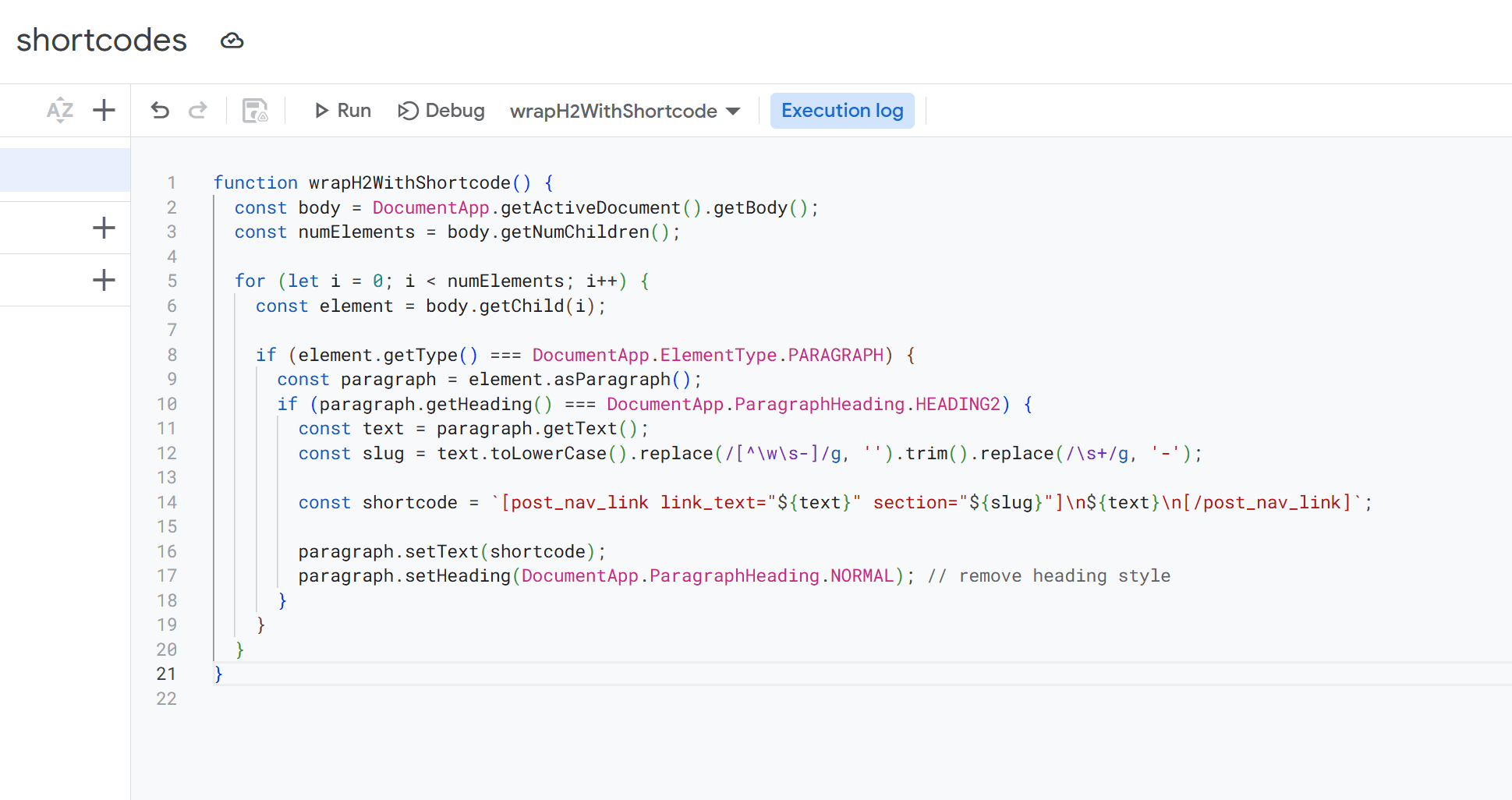

The way to get began:
- Be told key strategies like SpreadsheetApp, getRange(), and triggers like onEdit(). You’ll be able to discover those within the Apps Script documentation or glance thru examples on GitHub to peer how genuine tasks are constructed.
- Construct a script that sends e mail indicators or fetches information from every other Sheet. Should you’re new to JavaScript, check out beginning with JavaScript.info, MDN’s JS tutorial, or W3Schools JavaScript basics. Those will permit you to perceive the core programming ideas that Apps Script is dependent upon.
- Use ChatGPT to write down, provide an explanation for, and debug your Apps Script line-by-line.
Should you’ve ever imported e mail lists or GA4 exports, you understand: uncooked advertising information is chaos.
Python’s Pandas library is constructed to scrub and turn into that chaos into blank, structured insights. It’s a Python library that makes it simple to filter out, blank, and reshape spreadsheet-style information.
I’ve slightly scraped the outside of the Pandas library, however I already use it deduplicate rows, normalize UTM parameters, and mechanically reformat uncooked exports into the appropriate structure for my per 30 days reporting.
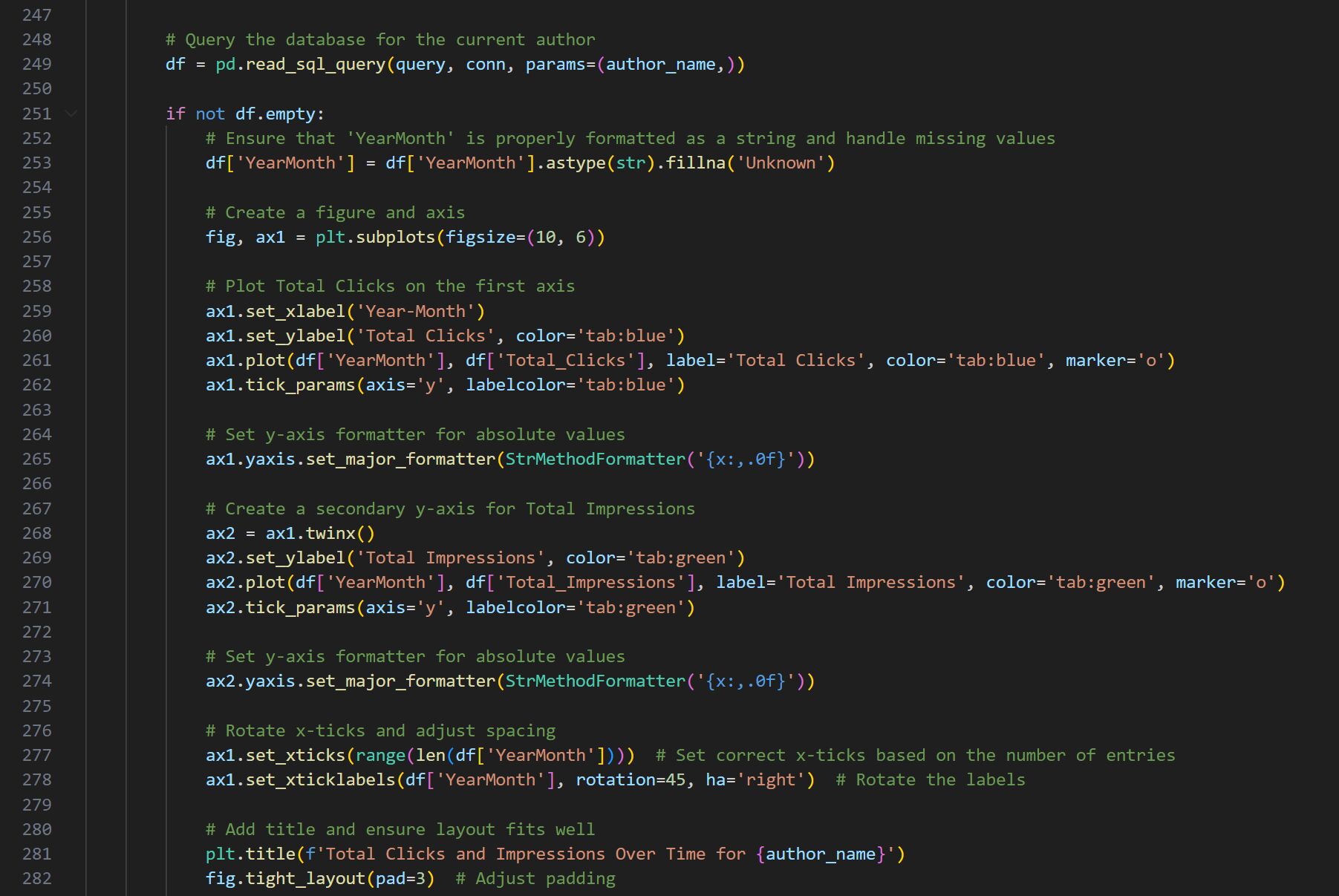

Pandas’ information frames are an important for my weblog reporting automations.
The way to get began:
Having the ability to construct dashboards or charts is helping you get buy-in quicker and discover patterns that uncooked spreadsheets leave out.
Looker Studio is likely one of the perfect tactics to construct customized dashboards out of your advertising information—with no need to code or use BI gear.
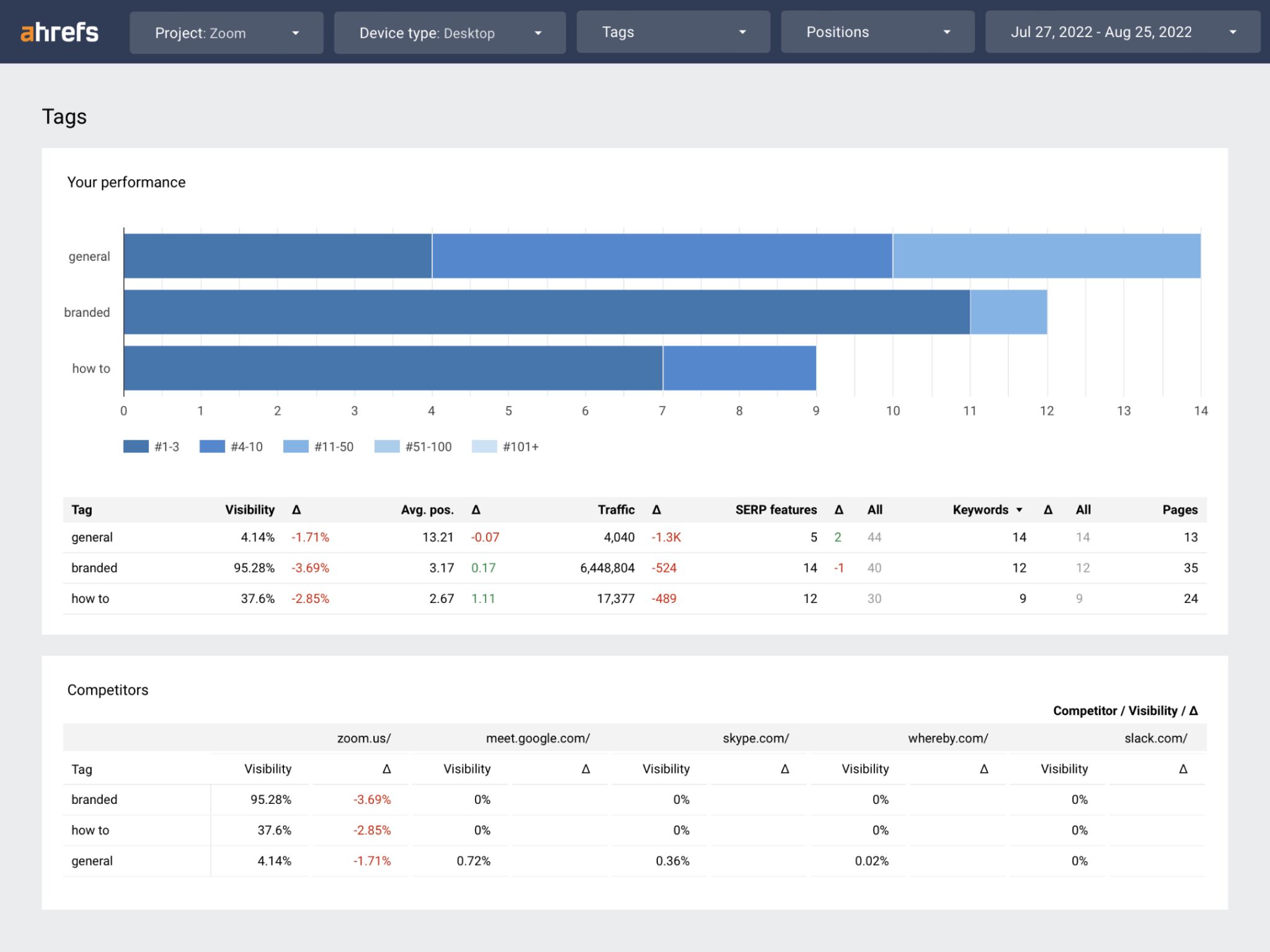

Ahrefs now provides a right away integration with Looker Studio, so you’ll be able to pull in search engine marketing metrics like site visitors, inbound links, key phrase scores, and web page audit information to construct real-time dashboards with out exporting CSVs. That suggests much less guide reporting and extra time spent examining developments throughout content material, campaigns, or competitor domain names.
You’ll be able to discover ways to set it up in this guide.
The way to get began:
- Attach Google Sheets, GA4, or Ahrefs without delay to Looker Studio. Follow this guide to get started.
- Create visualizations like bar charts, pie charts, and time collection with calculated fields.
- Use ChatGPT to lend a hand write Looker formulation, mix information assets, or troubleshoot damaged charts.
Want structured information from web pages that don’t be offering APIs? Scraping public pages is one choice—whether or not you’re collecting tournament listings, process forums, or weblog metadata at scale.
(Simply take note: no longer each and every web site desires to be scraped. All the time test their robots.txt record and phrases of carrier sooner than you get started.)
If you need a secure get started venture, check out the usage of BeautifulSoup and ChatGPT to scrape publicly to be had product information from the Books to Scrape demo web page, which is designed particularly for training internet scraping. Attempt to extract titles, costs, and famous person scores, then arrange the information right into a spreadsheet for research. For the reason that web page is constructed for finding out, it’s a secure and accountable position to sharpen your scraping talents.
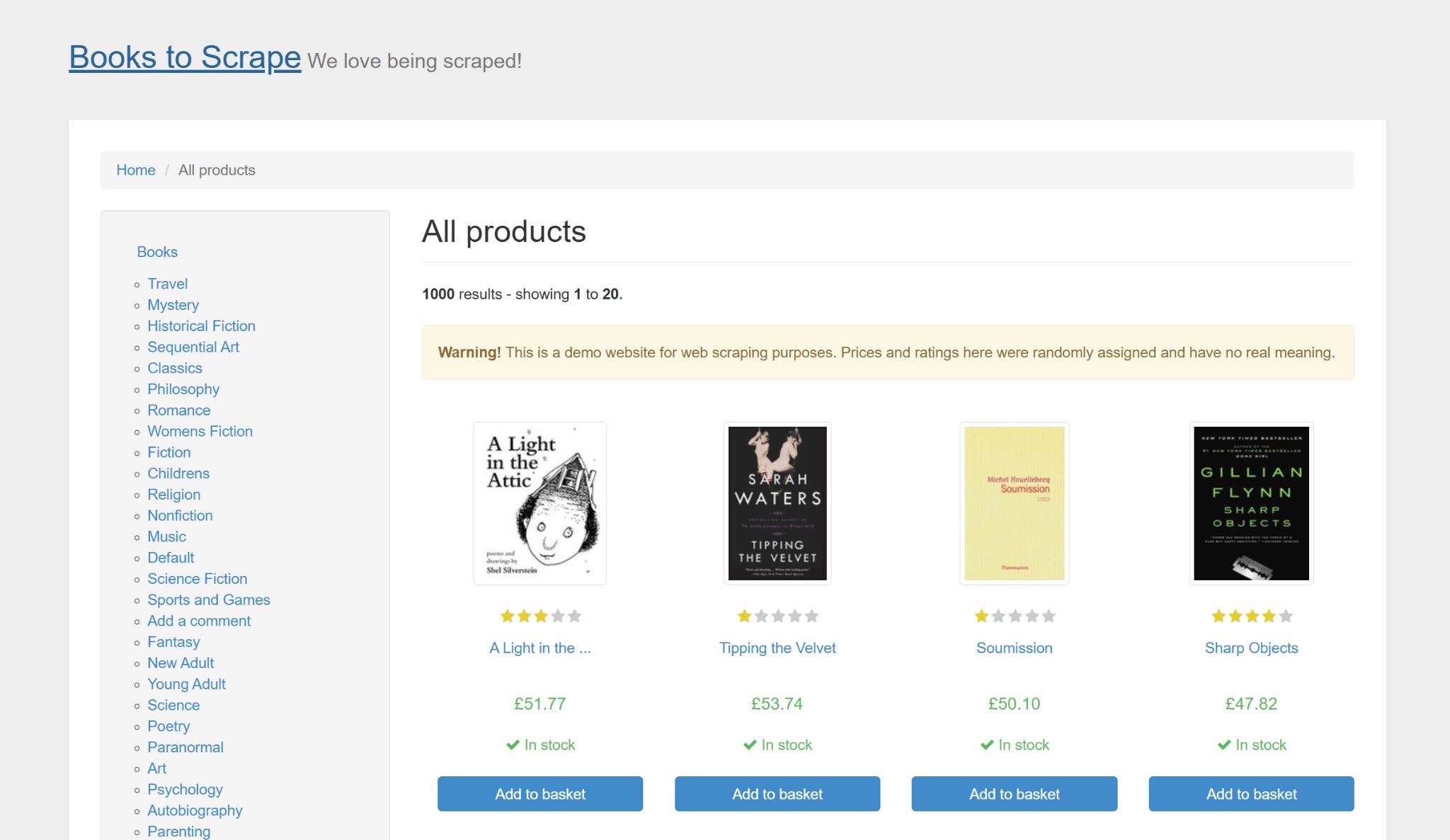

Books to Scrape is a web page that actively encourages scraping.
The way to get began:
- Be told Python fundamentals and set up libraries like BeautifulSoup and Requests.
- Apply scraping your personal web page to steer clear of breaking anything else. You’ll be able to additionally check your talents on websites that explicitly permit scraping—like Books to Scrape, a demo e-commerce web page constructed for this function.
- Ask ChatGPT to generate scraper scripts, provide an explanation for the good judgment, and maintain pagination or user-agent headers.
You’ve almost definitely spotted that I really like Python. Python is the spine of lots of cool workflows—it’s the way you cross from spreadsheets and guide processes to genuine automation.
Studying any coding language is clearly a large ongoing dedication, however even a small quantity of fluency can will let you construct very cool issues.
With lend a hand from ChatGPT, I’ve automatic duties like exporting weblog efficiency information from Google Seek Console and visualizing it for my per 30 days content material file, downloading favicons for my “top companies” lists, and extracting conceivable key phrases from podcast transcripts.
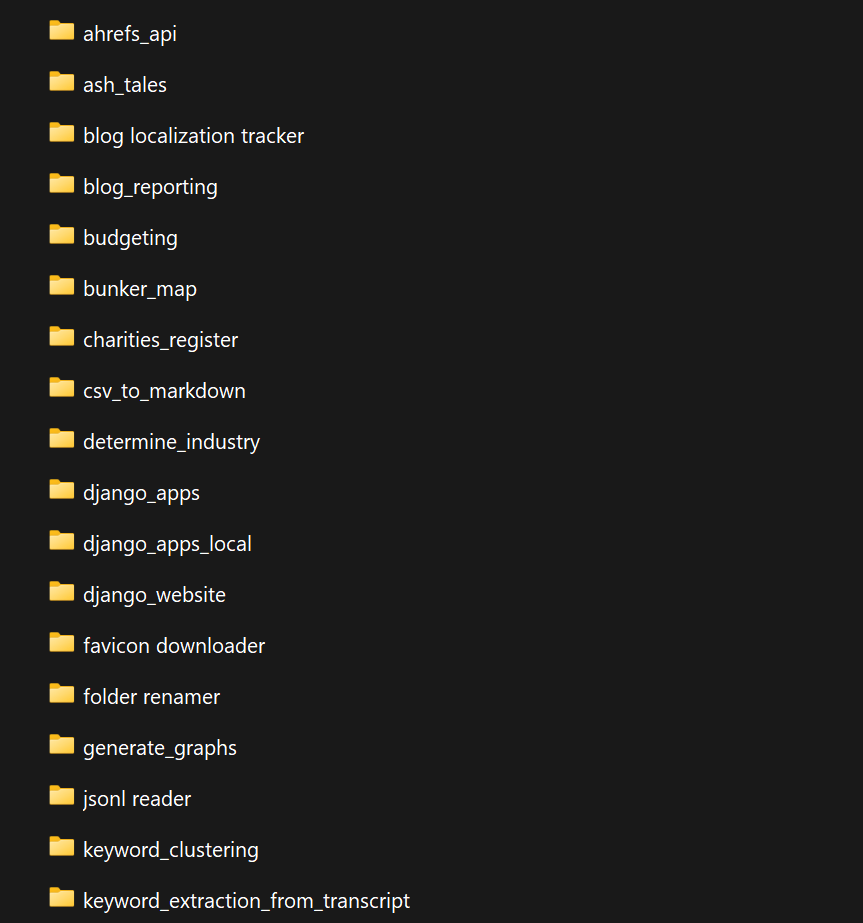

A handful of my newbie Python tasks.
The way to get began:
- Be told fundamental syntax (variables, purposes, loops). One good spot to begin is Replit’s unfastened 100 Days of Python, which mixes bite-sized classes with hands-on coding workouts proper to your browser—no setup required.
- Use os, csv, and re libraries to automate duties like renaming, cleansing, and categorizing.
- Ask ChatGPT for Python scripts adapted on your workflow and feature it provide an explanation for the code.
Whilst Airtable and Perception are no-code gear (therefore “non-technical”), they lend a hand provide an explanation for how relational databases paintings: how other tables attach, how information sorts affect habits, and methods to construction your knowledge for simple querying and automation.
Those are foundational ideas that no longer handiest make you higher at the usage of Airtable, but in addition dramatically make stronger your spreadsheet sport and prep you for extra complicated gear down the line.
I’ve used Airtable specifically to construct light-weight CRMs, programmatic SEO strategies, and whole content material control methods, able to monitoring briefs, drafts, post standing, and function.
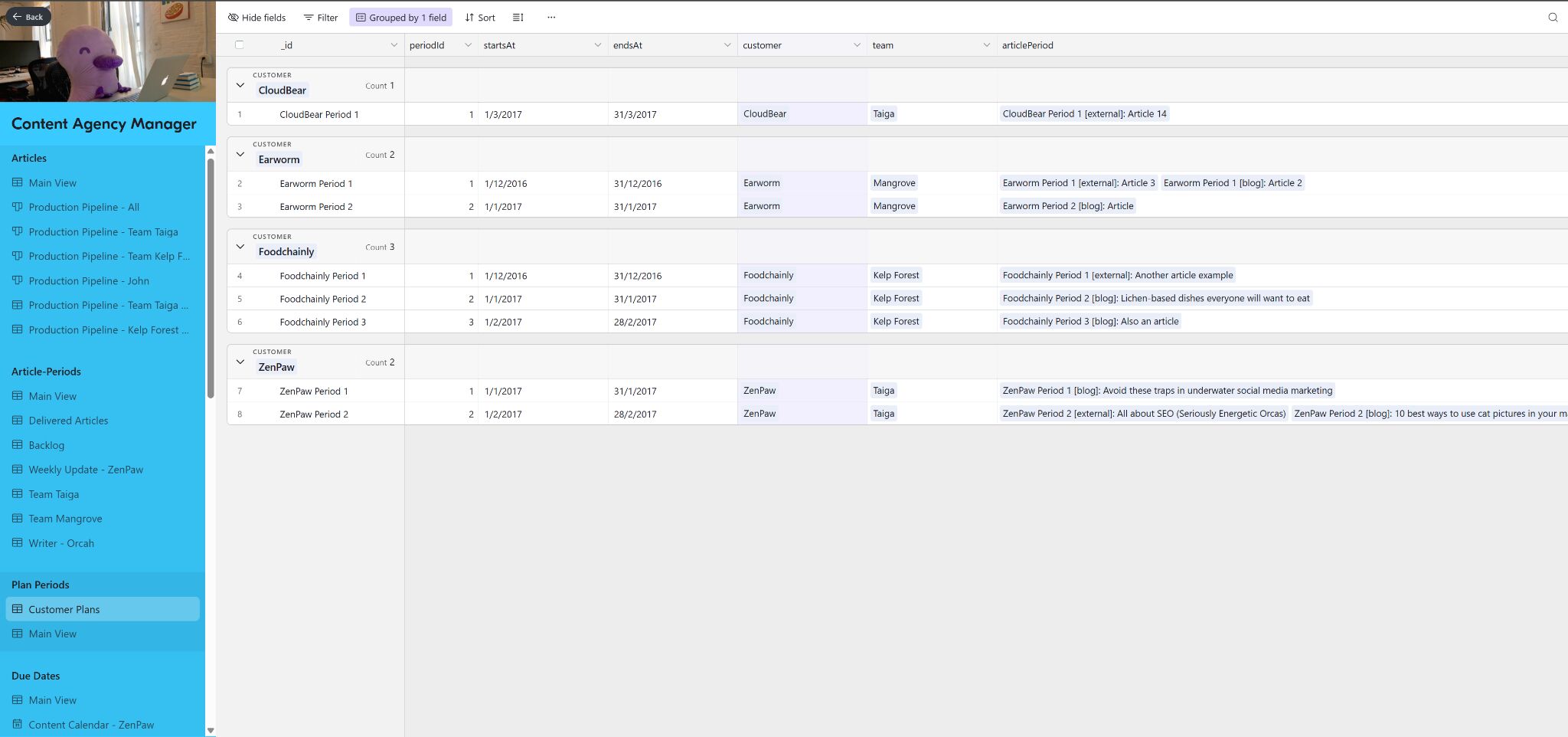

Right here’s an instance content material control machine we constructed for our advertising company, long ago in 2017.
The way to get began:
- Create a base in Airtable or desk in Notion with fields like standing, proprietor, due date.
- Construct perspectives to filter out by means of content material kind, creator, or due date.
- Use ChatGPT to draft formulation, counsel schema enhancements, or automate with buttons.
Pivot tables are one of the crucial robust tactics to research massive units of spreadsheet information—with out writing a unmarried components.
I used to make use of them a ton in my weblog reporting: to summarize content material efficiency by means of creator, spot developments throughout other content material sorts, or even discover correlations between post cadence and site visitors.
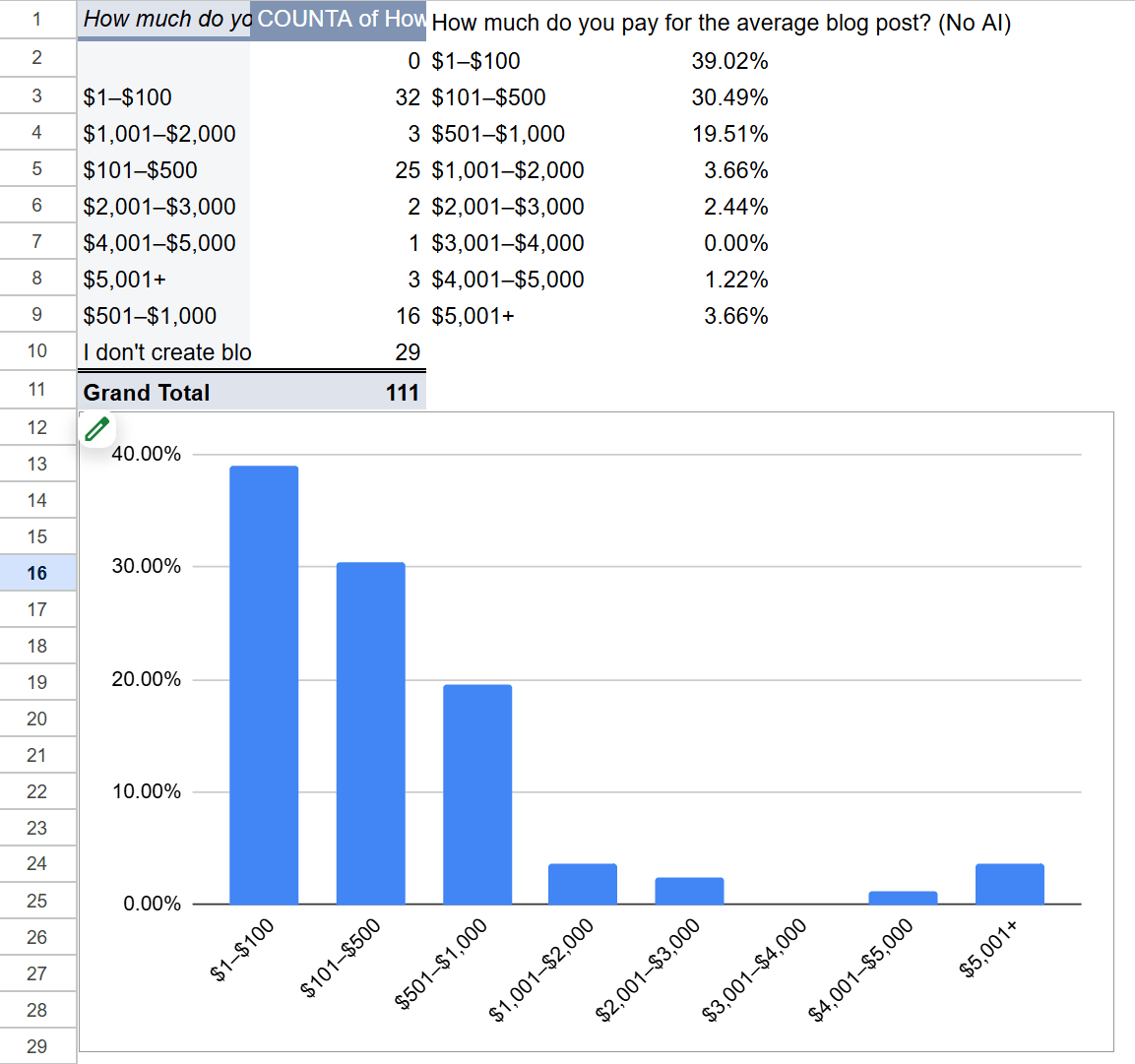

Right here’s an actual pivot desk from our fresh AI in content material advertising survey. The pivot desk turns lots of unwieldy information into particular, helpful analyses.
The way to get began:
Regex (brief for Common Expressions) is a compact language for locating patterns in textual content. Whilst it appears intimidating to start with, it’s one of the crucial helpful technical talents you’ll be able to pick out up—and it’s very best for entrepreneurs drowning in messy information.
I’ve used regex to scrub UTM parameters, extract domains from referral URLs, filter out URL lists to search out simply global subfolders, validate e mail codecs, or even pull key phrases from content material briefs. It’s particularly helpful for filtering in Ahrefs: Site Explorer and Site Audit both accept regex queries:
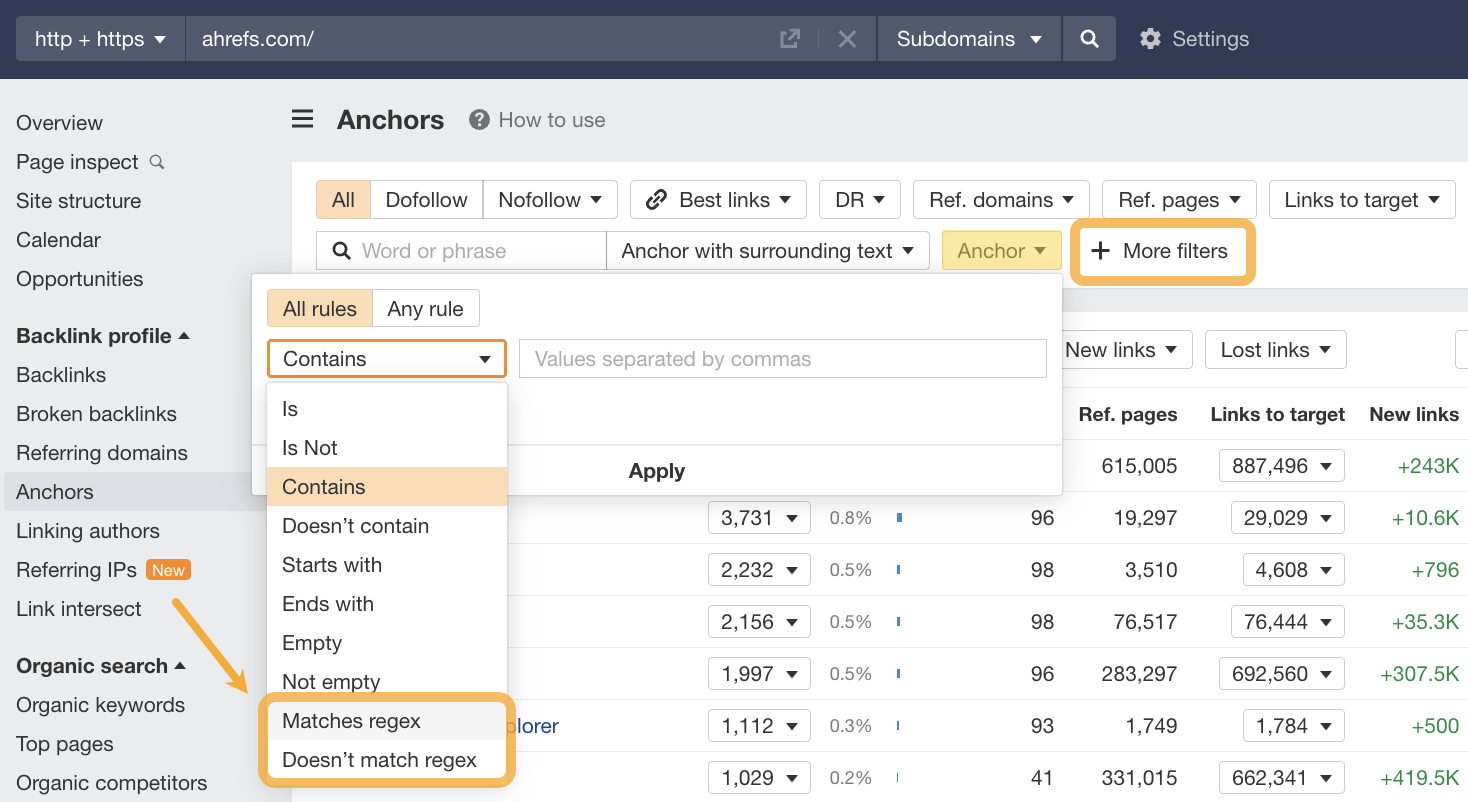

The way to get began:
- Take a look at unfastened RegEx trying out gear like Regex101 or RegExr, which spotlight suits and provide an explanation for the good judgment.
- Get started small: fit e mail addresses, isolate URL slugs, or blank marketing campaign tags.
- Use ChatGPT to write down expressions for you—simply describe the development you need, and it could generate and provide an explanation for it line-by-line.
- Be told the place Ahrefs accepts regex.
- For hands-on guides, take a look at Regular Expressions for Beginners and JC Chouinard’s Regex for SEO.
Spreadsheets aren’t simply for easy sums—they’re one of the crucial robust (and underutilized) platforms for logic-driven advertising automation.
Whilst you mix formulation like ARRAYFORMULA, QUERY, REGEXMATCH, and IMPORTRANGE, you’re mainly writing light-weight code. It’s structured pondering, modular good judgment, and information manipulation—all with out touching a programming language.
I’ve used complicated formulation to automate per 30 days reporting dashboards, analyze search visibility trends, or even construct keyword clustering workflows without delay in Google Sheets. This bizarre nested components is a an important a part of my weblog workforce reporting dashboard:
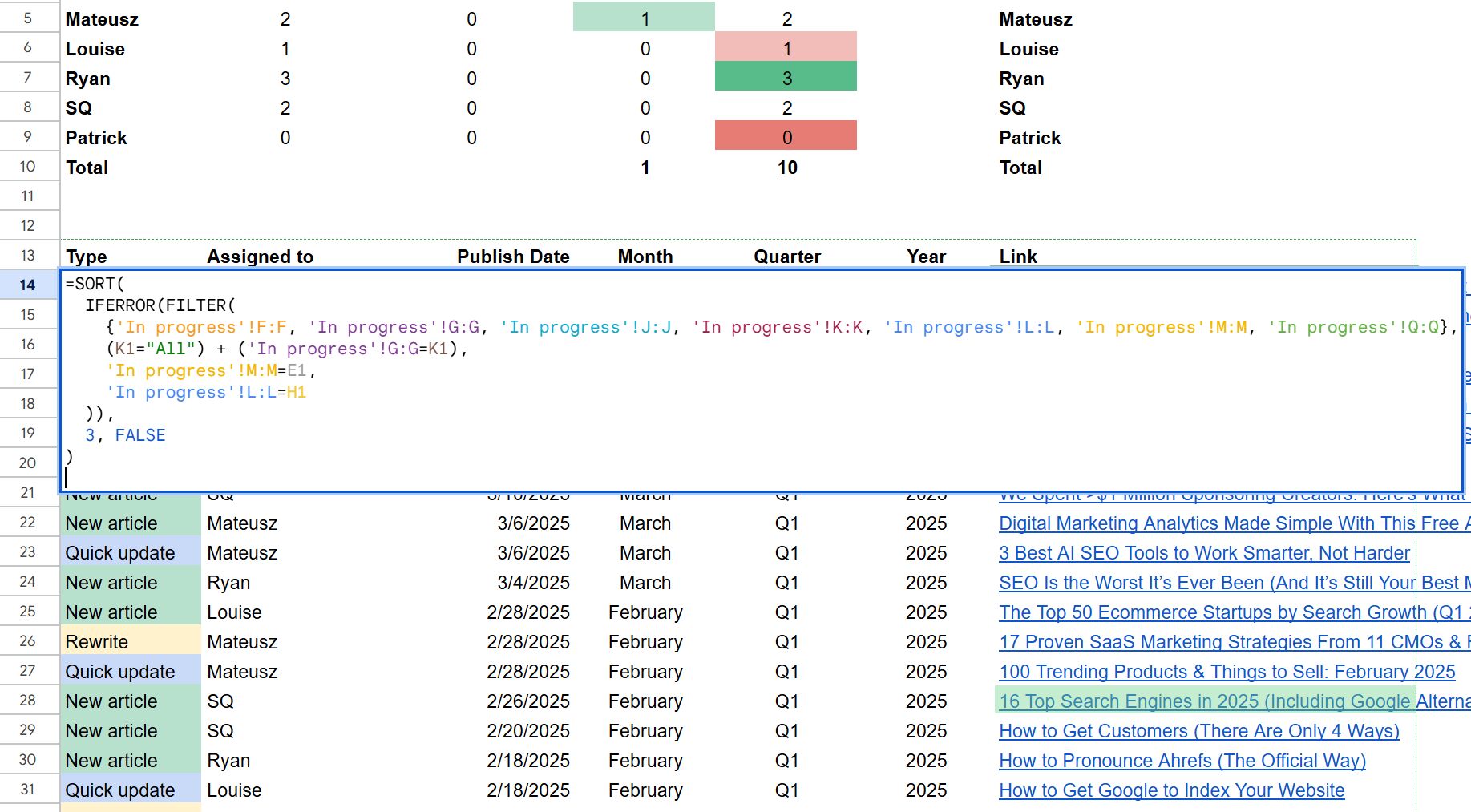

This type of fluency opens up massive leverage, particularly when paired with information from gear like Ahrefs. If truth be told, we wrote an entire publish about it: 29 Google Sheets formulas every SEO should know.
The way to get began:
- Find out how ARRAYFORMULA, QUERY, and FILTER can substitute guide copy-pasting with dynamic updates.
- Use IMPORTRANGE to mix information from other Sheets.
- Take a look at REGEXMATCH or REGEXREPLACE to scrub up messy UTM parameters or flag branded key phrases.
- Ask ChatGPT to lend a hand provide an explanation for formulation, debug mistakes, or optimize sluggish Sheets.
Let’s wrap-up with a meta ability: prompting.
There’s a large number of pseudoscience round prompting massive language fashions (LLMs)—other folks speak about it like magic spells. However in fact, there’s a science to just right prompting. It’s a technical ability that amplifies the entire others in this record.
Whether or not you’re asking ChatGPT to write down Python scripts, provide an explanation for SQL joins, or debug a components, the way you ask determines the standard of the reaction. Beneath is a listing of prompting methodologies gleaned from my enjoy and the instructional literature:
The way to get began:
- Supply grounding context. Should you’re the usage of ChatGPT or Claude, believe importing paperwork (by way of Initiatives) so the style has get entry to to related examples, information, or genre guides. That is necessarily a light-weight model of RAG (retrieval augmented technology).
- Use structured activates. Body your request with sections like: review, examples, what to steer clear of, and desired output structure. This is helping the style explanation why extra obviously and ship constant effects.
- Use delimiters to split content material. Enclose code, pattern information, or reference textual content in triple backticks (“ ‘) to steer clear of confusion and make stronger output formatting.
- Lean into emotional tone when suitable. Language like “you’re a world-class Python tutor” or “I’m actually caught—please stroll me thru this like I’m new” can impact how the style prioritizes readability and tone.
- Be told from very best practices. OpenAI’s guide and Simon Willison’s article on prompting be offering nice frameworks for making improvements to reliability and output high quality.
Ultimate ideas
The most productive entrepreneurs aren’t simply inventive thinkers—they’re technical sufficient to in truth execute, too. And now, with LLMs like ChatGPT, there’s no excuse. You may have a 24/7 tutor, debugger, and strategist to your pocket.
Don’t simply ask AI to do issues for you. Ask it to show you. That’s the way you construct genuine, sturdy talents. So pick out this kind of technical talents, give your self a weekend venture, and use AI to degree up.













